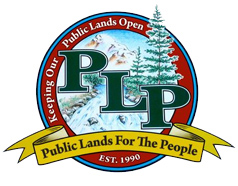The Power of Mining Districts
March 12, 2015
The Power of Mining Districts
by Clark Pearson
Director, Northern Office
Public Lands for the People
_______________
by Clark Pearson
Director, Northern Office
Public Lands for the People
_______________
The 1872 Mining Act was Congressional acceptance that miners can make needful federal rules and regulations governing their activities on federally managed lands. Specifically codified under 30 U.S.C. sections 22 and 28. Section 22 states:
“Except as otherwise provided, all valuable mineral deposits in lands belonging to the United States, both surveyed and unsurveyed, shall be free and open to exploration and purchase, and the lands in which they are found to occupation and purchase, by citizens of the United States and those who have declared their intention to become such, under regulations prescribed by law, and according to the local customs or rules of miners in the several mining districts, so far as the same are applicable and not inconsistent with the laws of the United States.” (Emphasis added.)
Essentially, this is by the miners, for the miners. This grant from Congress enabled miners in their respective mining districts to regulate their own pursuits subject to the laws of the United States. Most of the previous rules and regulations by miners in their respective mining districts were reabsorbed into state law. With the miners choosing to organize the traditional mining districts, they shall have federal supremacy over conflicting state and federal law upon federal lands.
- The Mining Districts shall override conflicting state and federal laws that stand as obstacles to the full Congressional objective of the 1970 National Minerals, Mining, Reclamation and Policy Act (30 U.S.C. section 21a) and the 1955 Multiple Surface Use Act (30 U.S.C. 612 sections a - b).
- The Mining Districts shall intervene upon the miner’s written request to resolve conflicts that unreasonably interfere with the miner’s right to extract, as defined in U.S. v. Shoemaker. Said in another way, the miners will police themselves, and the Mining Districts will have the first right to mitigate any claim disputes before going to the Interior Board of Land Appeals or any other federal or state court.
- The Mining Districts shall be the arbiter of reasonable environmental and safety regulation(s). (See footnote 1.)
- And most importantly, the Mining Districts can open the federal land to multiple-use by the public on principles of inclusion rather than the present day exclusions carried out by the extremist environmental lobby groups that work inside and outside all the other various agencies. (See footnote 2.)
“A wise and frugal government, which shall leave men free to regulate their own pursuits.”
-- Thomas Jefferson, 1801, on what constitutes good government.
Miners, in their respective Mining Districts, have the ability to duly elect representatives to make rules and regulations governing their mining activities (customs of miners) in contrast to executive agencies that currently answer to the whims of the President and the bureaucracy. These duly elected representatives will have a proposed term of 4 years such that they will be accountable to their constituents -- the individual miner -- just as it worked in the 1800’s. And quite successfully I might add.
 Once the organized Mining Districts take shape, the Minerals and Mining Advisory Council (MMAC) can and will submit to Congress for a budget for the administrative functions and clarifications of the Mining District’s relationship with the other federal and state agencies. The MMAC website will have a resource section which explains what your fundamental rights are as miners. The claim owners in those districts elect all the miners that represent the districts and upper tiers - nobody is appointed.
Once the organized Mining Districts take shape, the Minerals and Mining Advisory Council (MMAC) can and will submit to Congress for a budget for the administrative functions and clarifications of the Mining District’s relationship with the other federal and state agencies. The MMAC website will have a resource section which explains what your fundamental rights are as miners. The claim owners in those districts elect all the miners that represent the districts and upper tiers - nobody is appointed.
Presently, MMAC has developed some preliminary guidelines and clarifications (changes to HR 761 rev. 8, and ESA reform) and handed them to the Congressional House Subcommittee on Resources and Minerals. This preliminary notice from MMAC to Congress is open for more discussion but covers and fixes many of the problems the mining industry faces that have hit most miners especially hard. There are severe ambiguities in law that need clarification that stand as obstacles to the accomplishment of the National Minerals, Mining and Reclamation Policy Act of 1970 (codified under 30 U.S.C. 21a).
The MMAC will need the active participation of every miner, every mining organization, every claim holder and any other group that shares the multiple-use principles of our public lands. The tasks before us are for Americans that strive for accountability, self-determination, and for laws that are for and by the people. It could be said that miners can shine the light on the proper role of government in the darkest of tunnels.
Mining District Advisory Council website: http://www.mineralsandminingadvisorycouncil.org/
Ben Franklin once was asked to comment about our newly formed government of the United States of America, and he said, “It’s a republic, madam – if you can keep it.”
Now I ask the miners of today, we have Mining Districts -- can we keep and run them?
_______________
1. Before any agency such as EPA, DFG, DEQ, USFS, MSHA can carry out any existing or proposed regulations on the mining community, they must first get approval from the Mining Districts to implement them. (Clarified in modified HR761)
2. Items for example: roads currently closed now will be evaluated by the Mining Districts for determination on leaving them open to the public as intended.








